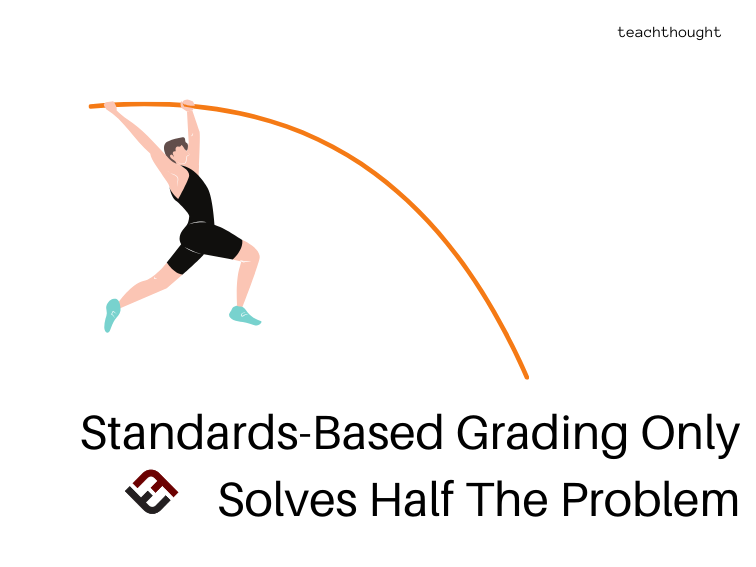
Why Standards-Based Grading Only Solves Half The Problem
经过Grant Wiggins,Authentic Education
Ed note: On May 26, 2015, Grant Wiggins passed away. Grant was tremendously influential on TeachThought’s approach to education, and we were lucky enough for him to contribute his content to our site. Occasionally, we are going to go back and re-share his most memorable posts. This is one of those posts.幸运的是他的公司Authentic Education, is carrying on and extending the work that Grant developed.
This article was first published in 2014 and most recently updated in March of 2020
Over the last few months, I have worked with a number of high schools and middle schools where the grading and assessment practices simply do not work in a world of standards. The schools are not making local assessment rigorous enough in their concern with demoralizing students through low grades. The solution is straightforward: don’t thoughtlessly translate scores into grades.
The problem. schools have to meet standards, and local assessment should prepare kids to deal with the standards as tested by PARCC and SB. But the new tests are harder and more rigorously scored than most local tests. So, scores will have to be low. (Anyone following NAEP results has known this for years, alas.) This seems to run headlong into a long tradition of grading whereby we do not want to punish kids with low grades (akin to the outrage over sharply-lower school scores on accountability measures this year).
Yet, there seems to be no alternative: to significantly raise local standards of performance seems to mean we have to lower student grades. Or, conversely, we can keep our current average grade of a B for students locally, but then have less rigor than is needed to prepare kids for the tests – and predict results on them (which local assessment should surely do if it is valid and useful).
Note that so-called ‘standards-based grading’ doesnotinherently solve this problem. Just because we go to standards-based grading doesn’t mean the grading is rigorous. In fact, if you look at schools that use standards-based grading, it is rare for students to get ‘scores’ that are vastly different from the range of ‘grades’ (thusalternatives to letter grades)以前在这样的学校中。即,我们正在在规范参考框架中进行基于标准的评分!当地未能假设根据标准评估足以建立严格。但这是不够的;它不能独自工作。
What Is Rigor?
Rigor is not established by the teaching. It’s not established by framing teaching against standards, therefore. Rigor is established by our expectations: how we evaluate and score student work. That means that rigor is established by the three different elements of assessment:
The difficulty of the task or questions
标准的难度,如专栏所确定的
预期的成就水平是由“锚”设定的或削减分数。
Many districts and schools don’t even pass the #1 criterion now. Routinely, when my colleagues and I audit local assessment, the tests are much easier than what the external tests test – even in pretty good districts. The usual explanation? The problem of fair grading.
请注意,从这三个要素中,即使是一项艰巨的任务和高质量的标题也不足以建立严格。这项任务可能具有挑战性和要求的标准 - 但是,如果对学生产品或绩效的期望非常低(由特定模型或本地规范确定),那么评估并不严格。这就是为什么在州测试中获得40或50的“削减”得分是一个可怕的解决方案 -ifthe goal is to communicate standards-based results vs. finding a way to pass most kids.
Think of the high jump or pole vault in track: you could enter a challenging event and be judged against the true criteria, but if the height you have to clear is absurdly low, then the assessment is not rigorous – even though it is ‘standards-based’ testing and scoring.
Solving The Problem
一个解决方案?避免基于虚假等效的思想计算。坚持使用田径以查看解决方案:我们不需要,实际上永远不会通过机械地将高度转换成一个任意但易于使用的公式来计算运动员的“等级”。为此,将极大地降低成绩,并为低技能的运动员提供强大的抑制作用。
On the contrary, we judge progress and performance relative to early jump heights and look for ‘appropriate’ growth, based on effort and gains in height. (I blogged previously about this point at greater lengthhere和here.) However, the expectations for all jumpers are high and constantly increasing.
The same solution is needed locally in academics, if genuine standards are going to be used to alert students as to where they are without discouraging them. (This is the idea behind theSLOs和Sgosin many states.) So, numerous times a year, their work needs to be evaluated against the external standards (as established by high-quality tests and student work samples). “But we have to give grades all year in our online grade book!” I know. But instead of turning their ‘score’ into a ‘grade’ by some unthinking formula, we use our wisdom and judgment to factor in fairness, growth, and effort on some uniform basis.
例如,假设在按照国家标准进行的写作评估中,我们通过从发布测试中剔除的国家样本来锚定评估。进一步假设使用了6点的标题。现在,假设在第一个政府中,例如在十月份,几乎所有学生都得到1或2个(其中这些分数是量表上最低的)。这是我们可能会说的beforethe scores are given to students and turned into grades:
“伙计们,我正在为您与该州最好的写作打分。因此,您今年秋天的一年级将反映出您现在的位置。得分为1等于b-。分数为2等于A B+。第一个学期的任何分数都是A - 是A - 。
“下学期,在冬季,要获得相同的成绩,您将不得不在规模上提高一个数字。到春季,您将不得不增加2个数字才能获得这些成绩。”
当然,在AP和IB课程中,这已经发生了。因此,在所有课程中都应该相对容易。因此,我们解决了问题:成绩变得公平,标准清晰,并且有动机随着时间的流逝而改善。
本文于2020年3月更新
本文摘自一篇文章首先出现Grant’s personal blog;Grant can be foundon twitter here; Standards-Based Grading Only Solves Half The Problem
